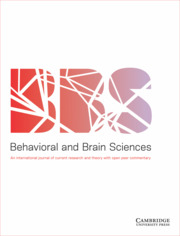Crossref Citations
This article has been cited by the following publications. This list is generated based on data provided by Crossref.
Gerrans, Philip
and
Murray, Ryan J
2020.
Interoceptive active inference and self-representation in social anxiety disorder (SAD): exploring the neurocognitive traits of the SAD self.
Neuroscience of Consciousness,
Vol. 2020,
Issue. 1,


Target article
A conceptual framework for the neurobiological study of resilience
Related commentaries (35)
Adding network approaches to a neurobiological framework of resilience
Animals can tell us more
Appreciating methodological complexity and integrating neurobiological perspectives to advance the science of resilience
Are positive appraisals always adaptive?
Beyond resilience: Positive mental health and the nature of cognitive processes involved in positive appraisals
Broadening the definition of resilience and “reappraising” the use of appetitive motivation
Careful operationalization and assessment are critical for advancing the study of the neurobiology of resilience1
Cognitive trade-offs and the costs of resilience
Do we know how stressed we are?
Does a positive appraisal style work in all stressful situations and for all individuals?
Heterogeneity of cognitive-neurobiological determinants of resilience
Integration of negative experiences: A neuropsychological framework for human resilience
Knowledge and resilience
Personality science, resilience, and posttraumatic growth
Phenotypic programming as a distal cause of resilience
Positive appraisal style: The mental immune system?1
Quantifying resilience: Theoretical or pragmatic for translational research?
Reappraisal and resilience to stress: Context must be considered
Rediscovering confidence as a mechanism and optimism as a construct
Resilience and psychiatric epidemiology: Implications for a conceptual framework
Resilience is more about being flexible than about staying positive
Resilience: Mediated by not one but many appraisal mechanisms
Resilience: The role of accurate appraisal, thresholds, and socioenvironmental factors1
Rethinking reappraisal: Insights from affective neuroscience
Social ecological complexity and resilience processes
Stability through variability: Homeostatic plasticity and psychological resilience
The challenges of forecasting resilience
The importance of not only individual, but also community and society factors in resilience in later life
The self in its social context: Why resilience needs company
The temporal dynamics of resilience: Neural recovery as a biomarker
The value of “negative” appraisals for resilience. Is positive (re)appraisal always good and negative always bad?
Toward a translational neuropsychiatry of resilience
What do we know about positive appraisals? Low cognitive cost, orbitofrontal-striatal connectivity, and only short-term bolstering of resilience
When at rest: “Event-free” active inference may give rise to implicit self-models of coping potential
“If you want to understand something, try to change it”: Social-psychological interventions to cultivate resilience
Author response
Advancing empirical resilience research